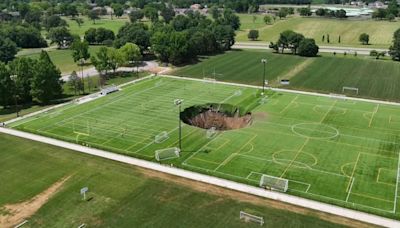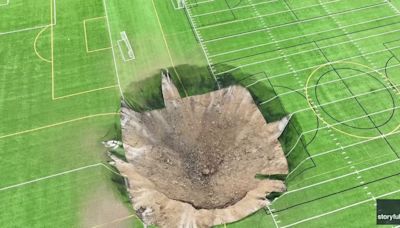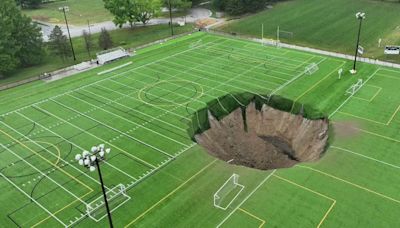Search results
- DictionarySink·hole/ˈsiNGkˌhōl/
noun
- 1. a cavity in the ground, especially in limestone bedrock, caused by water erosion and providing a route for surface water to disappear underground.
A sinkhole is a depression in the ground that has no natural external surface drainage. Basically, this means that when it rains, all of the water stays inside the sinkhole and typically drains into the subsurface. Sinkholes are most common in what geologists call, “karst terrain.”
Jun 9, 2018 · A sinkhole is an area of ground that has no natural external surface drainage--when it rains, the water stays inside the sinkhole and typically drains into the subsurface. Sinkholes can vary from a few feet to hundreds of acres and from less than 1 to more than 100 feet deep.
The meaning of SINKHOLE is a hollow place or depression in which drainage collects. How to use sinkhole in a sentence.
Oct 19, 2023 · A sinkhole is a hole in the ground that forms when water dissolves surface rock. Often, this surface rock is limestone , which is easily eroded , or worn away, by the movement of water. In a landscape where limestone sits underneath the soil, water from rainfall collects in cracks in the stone.
A sinkhole is a depression or hole in the ground caused by some form of collapse of the surface layer. The term is sometimes used to refer to doline, enclosed depressions that are also known as shakeholes, and to openings where surface water enters into underground passages known as ponor, swallow hole or swallet.
Apr 8, 2024 · A sinkhole is basically a hole which appears to suddenly open up in the ground. However, the process that leads to a sinkhole is not so sudden and may have been developing...
noun. A natural depression in a land surface formed by the dissolution and collapse of a cavern roof. Sinkholes are roughly funnel-shaped and on the order of tens of meters in size. They generally occur in limestone regions and are connected to subteranean passages.
Most sinkholes occur in places where water can dissolve the rock below the surface, for example where the bedrock is limestone, salt, or gypsum. They can collapse very quickly, or slump slowly over time. Many sinkholes occur naturally, but human activities can also cause them.
Sinkholes typically form when naturally acidic rainwater erodes underlying bedrock, creating damage beneath the surface. Their formation is most common in easily erodible karst terrains with...
Jun 26, 2017 · Sinkholes are pits in the ground that form in areas where water gathers without external drainage, according to the U.S. Geological Survey.




